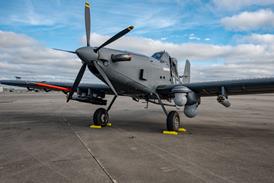In the world of airline alliances, few proposed so far have implications as great as that between Lufthansa and Scandinavian Airlines System (SAS) - not entirely from what is being done (though that is impressive enough), but also from what is not.
This deal pulls together, in a perhaps unexpected way, two more threads in the future make-up of the European airline industry. (Perhaps it should not have been unexpected after SAS' recent surprise selection of the Boeing 737 - a type it will have in common with its new partners - over the McDonnell Douglas MD-95 as its next small airliner.) It follows closely on the long-awaited tie-up between Swissair and Sabena, and leaves that European industry with a rather different shape than expected.
There has long been an assumption (justified or not) that the European industry would eventually coalesce around four major airlines - Air France, British Airways, Lufthansa and a combined SAS/KLM, possibly with Swissair. The latter had always seemed on the cards - the airlines have been linked through the Atlas maintenance consortium; they appear to have similar operating philosophies; and were involved in the ultimately abortive Alcazar project.
Now these cosy assumptions appear to be falling apart. With SAS seemingly firmly in the Lufthansa fold, KLM is left with its transatlantic link with Northwest Airlines but lacking the critical mass within Europe.
The number of teaming options left for it (or any other of the second tier of European airlines) is shrinking as the big alliances strengthen and other airlines (comparatively) weaken. At one time, the expansionist Iberia might have appeared a good potential partner for any one of the northern-European majors, but neither it nor Alitalia has much partner-appeal. The rump of what was to be the European Quality Alliance, before SAS "defected", (Austrian and Swissair) could offer the nucleus of a new grouping with Sabena, Delta and perhaps KLM, if the old Alcazar problems can be settled.
That is the global view: at a more local level, the Lufthansa/SAS tie-up is one with many more positives than negatives. The route structures of the two are largely complementary, rather than competitive; they already have other alliance partners, such as Thai Airways and Varig, in common; the link with those and United gives a near-global coverage for each partner. The downside really exists only in the existing links with other airlines which SAS, especially, may have to dismantle as being incompatible.
The greatest advantage should be (assuming this partnership does work) that of achieving a seamless service encompassing the USA, Europe and Scandinavia, with strong links to the rest of the world. Should the partners in this alliance so choose, it would be but a small step from there to establishing what could be, in effect, a global brand. Importantly, it would not be that dream of the early 1990s, a global airline.
None of the parties in this deal envisages, any equity transfer or exchange in making it work. Lufthansa has made investments where it felt they were prudent - such as its near-40% stake in Lauda Air - but the philosophy of its chairman Jurgen Weber has been to look for operational benefits rather than equity stakes. SAS (itself a consortium of the national airlines of Denmark, Norway and Sweden) has also made investments, but learned the lessons of over-ambition through its experience with a stake in Continental Airlines and the failed Alcazar talks.
The new partners, with United, now find themselves in competition with majors, which (with varying degrees of success) have been highly acquisitive, rather than alliance-driven, in particular, British Airways with its stakes in Qantas Airways and USAir.
The great danger of a non-equity alliance is that it is easier to unravel than an equity-based link, and lacks some of the essential feeling of permanence of the great mergers. As has been seen in the US regional-airlines market, a brand identity can swap tails with remarkable speed if equity is not involved. The Lufthansa/SAS deal represents a bold step for two strong and successful airlines: it might not, however, signal the inevitable emergence of one.
Source: Flight International























